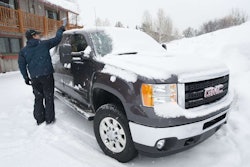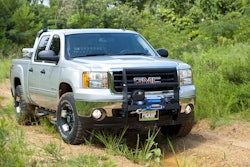Get the LED Out
 Throw away those antiquated warning lights and step up to the world of high-tech; new LED systems improve safety and efficiency while lowering operating costs
Throw away those antiquated warning lights and step up to the world of high-tech; new LED systems improve safety and efficiency while lowering operating costs
They are more compact, brighter, longer lasting, water- and vibration-proof and efficient than any other lighting source. That’s why those who need warning lights and auxiliary lighting on pickups and equipment are turning their attention to LEDs.
Utilizing LEDs (light-emitting diodes) as a commercial aftermarket light has been around for decades.
LED lights, all made overseas, are composed of separate LEDs each protected with a lens that’s part of the unit. From there it’s a wide-open offering of new lighting products for just about every need anyone in the heavy construction industry could ever want or need.
Where the differences arise between brands such as J.W. Speaker, Rigid Industries, VisionX, Whelen and the dozens of other light manufacturers is the size of the LEDs used in their products, how the LEDs are housed, the design of the focusing lenses and reflectors, the power supply, the quality of the mounts and wiring, and how the arrays are setup.
In the last couple years new strides in emitter and lens design, LED coatings, more efficient manufacturing processes, and wider applications for LED lights have greatly increased the demand while driving the price down to an attractive level for many working pros in the heavy construction/contracting trades.
From an efficiency standpoint alone, today’s newest crop of LEDs can’t be beat. Many LED manufacturers claim 50,000 hours of bulb life as opposed to the 1,000 to 1,500 hours of a halogen bulb or 2,000 for comparable HID lights. (This bulb life is estimated on the point at which users will notice a difference.)
HID and halogen lights are also susceptible to vibrations, so when used in off-pavement environments their life is cut even shorter while LEDs, which are semi-conductors mounted on circuit boards, keep on keeping on.
Where you might be replacing warning and auxiliary lights several times a year on pickups running “conventional” lights in more demanding conditions, most likely the truck will fall apart before an LED version of the same type needs replacing.
Since LEDs produce light by electrifying a material they illuminate quicker than conventional bulbs. This makes them good for signals, warning and brake lights where they can be clustered in groups and sequenced as needed for the application.
LED performance is related to the temperature of the components. Thus LEDs require relatively stable control so in very cold conditions the diode doesn’t produce too much light or get too hot where it degrades or shortens the unit’s life.
BETTER VIEW
Newer LED technology allows them to produce notably whiter light, nearing blue-white, than those of just 10 years ago. LEDs color temperature varies according to the amount of current passing through the semiconductor, so they can vary by design just as HID lights do.
But those that appear white are at about 6,500-degrees Kelvin, which equates to midday sunlight. (The 3000 to 3500K of tungsten-halogen lights is toward the yellow side.)
Whiter light is more natural to our brain, so there’s less eye strain when LEDs are used as auxiliary flood or work lights. (Note: color temperature has no bearing on brightness.)
Another big advantage LEDs have over their tungsten-halogen counterparts is their small size permits more options in design, which allows a physically smaller unit to supply the same amount of lighting in a more compact, lighter housing.
This small size is really taking new steps in the warning light arena where compact LED strobes are tiny enough to be mounted almost anywhere – and with built-in micro controllers they can function independently of others on the same vehicle if needed. This greatly reduces installation time.
LED EDGE
LED lamps are more efficient, too, delivering more light and less heat for the same power consumption.
Typical halogen lights, for example, use about five percent of consumed power for light generation and the rest is wasted in the generation of heat from the burning filament.
High intensity discharge (HID) lights that pass an arc through xenon gas have higher efficiency and last longer than halogen, but even they don’t match the efficiency or low-heat, high-light output of LEDs.
That’s not to say LEDs powering an auxiliary light or strobes don’t produce heat. They do. The heat’s generated at the emitters near the base and not with the light source. That’s a good thing as long as you don’t expect the LED lamp to melt snow and ice as you’re accustomed to in your plowing operations.
As light sources continue to evolve, the cost of LEDs will keep dropping and the efficiency will further improve. LEDs are getting larger as well, and the technology on focusing the light is making them even more diverse in application.
For example, LED fog, driving, flood and combinations of the latter are now available in a wide variety of sizes and shapes. LED lights from VisionX and Rigid Industries, for example, offer LED light bars and LED arrays that can light up a jobsite or road like it’s the middle of a sunny day.
Several warning light manufacturers offer compact multiple surface-mount units requiring only a small hole for wiring. There are even light bars that can be equipped with built-in solar panels to save the battery and idle time in sunny climes.
Control options include conventional switch banks, switching units, touch pads, programmable strobe heads that control multiple lamps and units with built-in programming that require only 12VDC and ground, most of which continue to get smaller, as does the wiring to them.
We found a couple of wireless controllers that might be handy for truck lighting while you’re up a pole or down a hole, or working in a lightly trafficked area that doesn’t require continuous warning.
These remotes are said to work up to 150 feet away, in 5- and 15-amp ratings, plus four-channel versions that offer patterns, flashing or dimming.
Careful consideration is needed for any LED unit you may add to your rig, and what it takes to remove it because it’s very possible the lights will outlast the vehicle they are going on.
FOR MORE INFORMATION
Code 3/PSE Amber, code3pse.com, (800) 972-1018
Grote Industries, grote.com, 800-628-0809
Hella, myhellalights.com, 770-631-7500
Rigid Industries, rigidindustries,com, 480-655-0100
Vision X, visionxusa.com, 888-489-9820
Whelen Engineering, whelen.com, 860-526-9504







